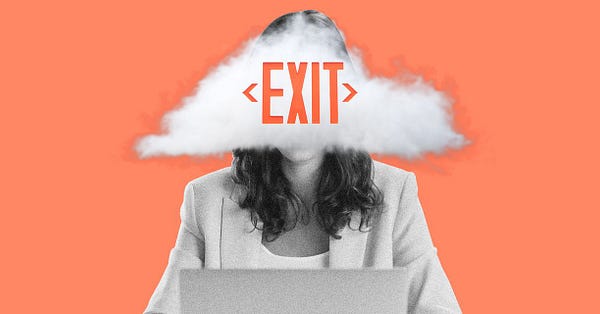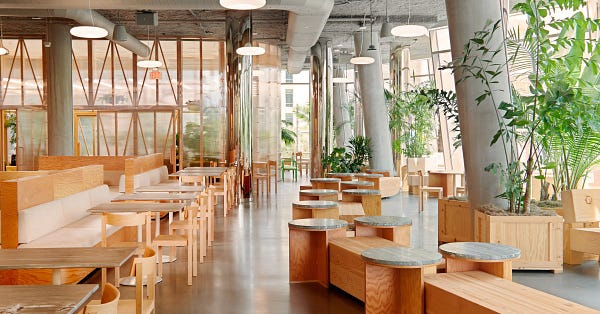Wednesday Walk: Quiet Quitting
Welcome to the Quarantine Creatives newsletter, a companion to my podcast of the same name, which explores creativity, art, and big ideas as we continue to live through this pandemic.
Every Wednesday, I share random thoughts and tidbits with links to let you do some exploring, which I hope generate interesting ideas. I call these Wednesday Walks, as it’s the type of conversation we might have walking down a path in the woods- the topics are free flowing, sometimes related, sometimes not.
If you like what you’re reading, you can subscribe for free to have this newsletter delivered to your inbox:
What Is Quiet Quitting?
I’ve written a lot about the changing face of office work (here and here, for starters). So I was intrigued when I saw this Wall Street Journal article by Lindsay Ellis and Angela Yang making the rounds:


The article points to a TikTok trend where young workers have started “quitting” their jobs by not actually resigning, but instead staying employed and opting to only do the work in their job assignment:
“The videos range from sincere ruminations on work-life balance to snarky jokes. Some set firm boundaries against overtime in favor of family. Others advocate coasting from 9-to-5, doing just enough to get by. Many want to untether their careers from their identities.”
The article has a sensational headline, but as you dig into it, it’s not really about people trying to be George Costanza, who acted frustrated and stressed as a way of seeming busy, but tried to do as little work as possible.
Instead, this trend seems to be about people still working hard when required, but also not taking home the stress of the office and feeling a personal need to solve every problem of a workplace:
“‘The most interesting part about it is nothing’s changed,’ [Clayton Farris, 41] said in his TikTok video. ‘I still work just as hard. I still get just as much accomplished. I just don’t stress and internally rip myself to shreds.’”
Quiet quitting is also about people setting realistic boundaries and not relying on office friendships, professional accomplishments, and a title to define them:
“Paige West, 24, said she stopped overextending herself at a former position as a transportation analyst in Washington, D.C., less than a year into the job. Work stress had gotten so intense that, she said, her hair was falling out and she couldn’t sleep. While looking for a new role, she no longer worked beyond 40 hours each week, didn’t sign up for extra training and stopped trying to socialize with colleagues.
‘I took a step back and said, ‘I’m just going to work the hours I’m supposed to work, that I’m really getting paid to work,’’ she said. ‘Besides that, I’m not going to go extra.’
Ms. West said that she found herself more engaged during meetings once she stopped trying so hard, and she received more positive feedback. She left the job last year and is now a full-time freelance virtual assistant making about 75% of her previous salary. She adjusted by moving back to her home state of Florida.”
I definitely feel aligned with some of this. I am satisfied in my work and do my job well during working hours, but I am also no longer willing only prioritize my career at the expense of the rest of my life. (You wouldn’t be reading this newsletter, for example, if this were 3 years ago when I only had time for my career and little else).
I used to think it was my responsibility to solve all of the problems at my company or that out-working everybody else would somehow get me a rung higher on the career ladder. Perhaps it’s just getting older or more experienced, but I now realize that I had an unhealthy perspective on all of this.
Is it possible that Americans are moving to a more European model of work, where family and vacations can co-exist with hard work? Or is this a temporary over-correction from the pandemic and the pendulum is already starting to swing the other way? Only time will tell.
An Alternative Office Plan
In the same vein, I also read an article from Bruce Horovitz in Time this week that looks at how Dropbox is handling return to the office:


The short version is that Dropbox, like many companies, realize that on site perks like snacks and gyms are no longer what attract top tier talent. Instead, flexibility is the most desired job perk.
To that end, Dropbox has given up most of their office space in San Francisco and pivoted to a model that’s virtual 90% of the time.
“This is a very important dot on the timeline of the shifting nature of work,” Drew Houston, CEO of Dropbox, tells TIME. “We’ve always believed that companies that give flexibility will outperform, out-attract, and out-retain the companies that don’t.”
On site gatherings must meet certain criteria to be scheduled and include events like group brainstorming sessions or trainings.
Perhaps the most progressive and interesting take on this is that Dropbox is allowing for more asynchronous work to take place. If it’s better for an individual to wake up early but then not be available during the afternoon, logging back on in the evening, that’s possible. Still, there are certain times when the whole staff is expected to be online at the same time:
“Dropbox developed “core collaboration hours” which requires members of each team to be at their computers—and available to communicate with all other team members—for a four-hour block each day. (That’s typically 9 a.m. to 1 p.m. Pacific time and 12 p.m. to 4 p.m. Eastern time.). That’s also when virtual group meetings are held. The other four hours are for working on personal projects or sometimes attending to personal needs.”
If the WSJ article is an indication of where worker sentiment is, Dropbox’s approach seems to be willing to meet that. It also strikes a balance that is beneficial to both the employee and the business.
As it seems like the pandemic may be closer to the rear view mirror, it’s reassuring to know that companies and workers have learned from this time and are willing to make big changes moving forward.
People, and especially business leaders, who have been hankering to “get back to normal” for more than two years will need to recognize that the environment has changed or risk losing talent.
There may not be a mass exodus overnight, but over time, I think employees will seek out businesses that offer the most flexibility and autonomy, and those which mandate certain hours or work arrangements will lose.
I’m curious to hear if your relationship to work has changed over the last two years. Are you a “quiet quitter” or are you working harder than ever? How do you establish healthy career boundaries? Leave a comment; I’d love to hear from you!
Other Wednesday Walks
If you’d like to catch up on past episodes of the Quarantine Creatives podcast, they can be found on Apple Podcasts, Spotify, or wherever you listen.
Please consider sharing this with a friend that you think might enjoy it, or better yet, share it on social media so you can tell hundreds of friends!
If you’ve missed past issues of this newsletter, they are available to read here.
Stay Safe!
Heath






